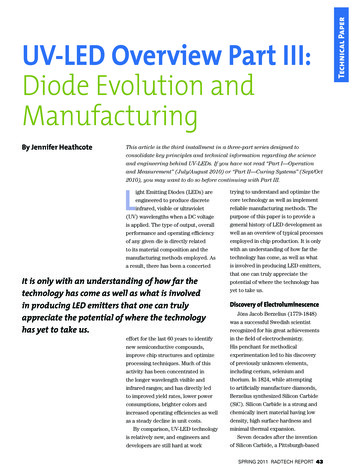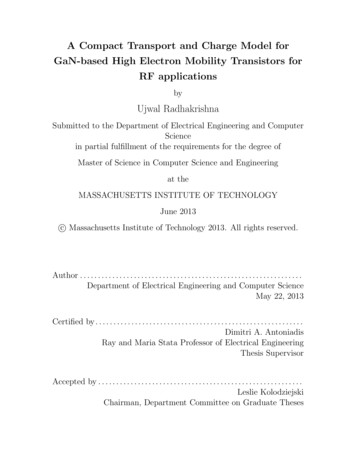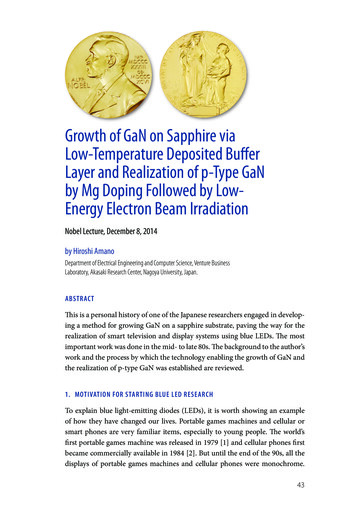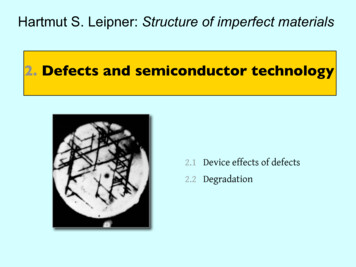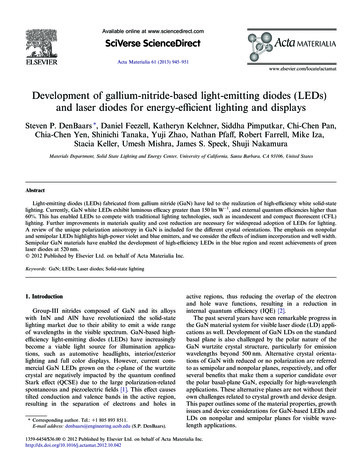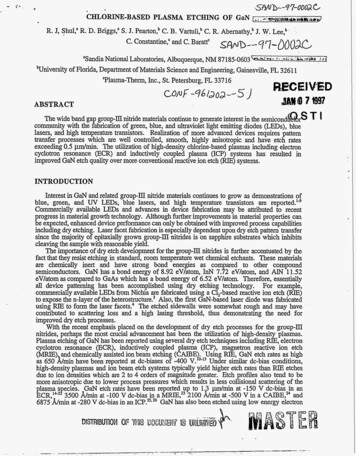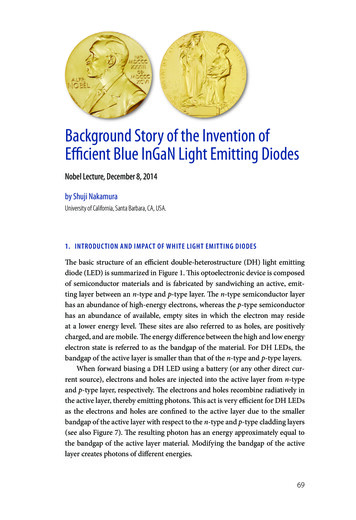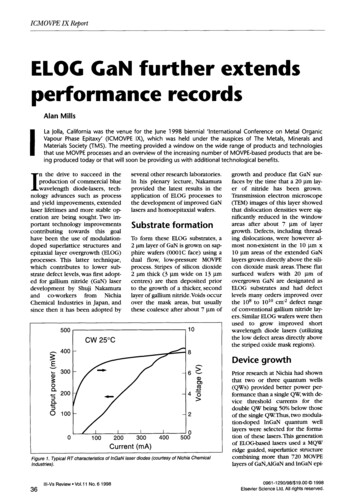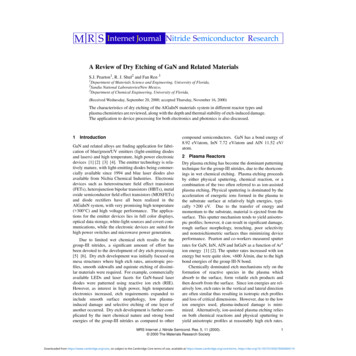
Transcription
Colorization Using ConvNet and GANQiwen Fuqiwenfu@stanford.eduStanford UniveristyWei-Ting Hsuhsuwt@stanford.eduStanford UniversityAbstractMu-Heng Yangmhyang@stanford.eduStanford UniversityThe ultimate goal is to color manga. However, it is difficult to obtain one-to-one correspondence of uncolored andcolored manga images as training data. Therefore, we manufacture uncolored manga images based on colored images.Typical uncolored manga are consisted of black and white,with some use of screentone (dotted texture) to apply shadesand grayscale effect. We manufacture two types of images:grayscale and edge-only from color images to simulate uncolored manga, which should be in between these two typesof estimations. The two types would both be the input of ourmodels and evaluated.We propose two models for this task: ConvNet andGAN. Both models are design to take either grayscale oredge-only images and produce color (RGB) images. Whilethere are previous work of similar types of networks oncolorizations, there are not work tailored specific to mangacolorization based on animation. Since colorings in animations are typically more fictitious and whimsical comparingto real-life photos, it would also be an interesting aspect tocompare how our neural network would color a specific object as opposed to one trained on real-life photos.Colorization is a popular image-to-image translationproblem. Because most people nowadays still read grayscale manga, we decided to focus on manga colorization.We implemented two models for the task: ConvNet andconditional-GAN and found that GAN can generate betterresults both quantitatively and qualitatively. Since somemanga only contains edges instead of grey-scale images,we also experimented with both inputs and test on varioussources of animations and found that using grey-scale images can lead to clearer boundaries and brighter colors.Many examples of generated images and error analysis arediscussed in the last part.1. IntroductionAutomatic colorizations is an area of research that possesses great potentials in applications: from black & whitephotos reconstruction, augmentation of grey scale drawings, to re-colorization of images. Specifically, we willinvestigate a subcategory of colorizations: automatic colorizations in Manga (Japanese comics). Most Manga aredrawn without colors until they are made into animationsand aired on televisions. We think automatic colorizationin Manga can be beneficial in providing readers with morepleasant and comprehensive reading experience, though itcan also be generalized and expected to work on any handdrawn images.We envision the applications to be two-folded: 1) themodel can be trained specific to a particular animation, andapply on not-yet animated manga to automate the colorization step of animations. This way the model can learnhow particular characters/animals/objects should be colored. The model can also be 2) train on myriad of animations and learn how to color drawings in general. We focuson 1) in our project due to limited resource and time to collect wide variety of training data. However, we will touchon 2) by testing on different mangas to evaluate the colorization capability on different styles of drawings by training ona particular animation.2. Related Work2.1. Colorization with hintHint-based colorization requires human supervision tocomplete the colorization. There are two popular hintbased colorization: scribble-based method and color transfer method. Scribble-based method proposed by Levin et al.[9] is very effective and popular. Fig. 1 is an example figurefrom the original paper. Given a user-drawn colored scribble, the model can colorize the area with that color-tone using convex optimization. The model can easily generatehigh quality image because the model doesnt really learnhow to color a specific item. Its more like children coloring book with a parent telling which color to use. There aresome extended works. Yatziv et al. [17] use chrominanceblending for video colorization. Qu et al. [11] improve continuity of colorization on similar textures for manga.Another famous hint-based colorization is the transfercolorization method proposed by Welsh et al. [16] and Ironi1
[12], Conditional-GAN [10], iGAN [18], and Pix2Pix [6].DCGAN [12] stacks deep convolutional neural nets as generator and discriminator to learn hierarchical visual representation. DCGAN is nowadays the standard architecturefor image generation. Instead of generating images fromrandom noise, conditional GAN [10] is given a conditionto generate an output image. For example, gray-scale image is the condition for colorization. iGAN [18] is an extension to conditional GAN. Similar to scribble-based colorization mentioned above, given the colored scribbles ofdifferent patches, iGAN can generate the image accordingto the scribbles. Pix2Pix [6] is conditional-GAN with images as the condition. Besides learning the mapping frominput image to output image, it can also learn a loss function to train this mapping. It is consider the state-of-the-artin image-image translation problem like colorization.Figure 1. Example of scribble-based colorization methodet al. [5]. Besides grayscale image, the model needs anothercolored image for reference. The model can match the information between the grayscale image and referenced image. For example in Fig. 2, both images have faces, thenthe model will learn to color the grayscale image with skinand hair color in the referenced image.3. Methods3.1. ConvNetsThe ConvNets model uses convolution layers in anencoder-decoder fashion to generate colorized images frominput grayscale or edge-only images and use pixel-wise L2loss as the objective function.Figure 2. Example of transfer colorization method3.1.12.2. Fully Automated ColorizationArchitectureThe ConvNet is consisted of a few layers of encoder anda few layers of decoder to generate colorized images frominput grayscale images or edge images. For a deep convolution neural network without dimension reduction, oneserious problem is that the size of output tensor will remains the same (180x320) after every layer, and therebylead to very large memory consumption. With strides largerthan 1 in each conv2d layer, the tensor shape will shrinkquickly. This is what the encoder is doing. We can then useconv2d transpose to upsample the tensor back to the original shape to get the color images, which is the function ofdecoder. Using this model can lead to much more compactfeature learning in the middle of the layers without consuming large memory.The architecture of our ConvNet model is symmetrical:it consists 6 layers of encoding and 6 layers of decoding;with increasing number of filters when encoding and decreasing number of filters when decoding. Each encodinglayer is consisted of a conv2d for downsizing, batch normalization, and leakly relu activations; each decoding layeris consisted of a conv2d transpose for upsizing, batch normalization and relu activations. However,at each decodinglayer, we concatenate the mirroring layer from encoder before moving on to the next one, creating ability for networkto skip layers. This architecture is called U-Net [13]. Withskipped layers, the model can learn weights to ignore deeperDespite the quality of the results, the hint-based modelsstill requires lots of human labor to generate hints. Thereby,fully automated colorization models that requires only grayscale are proposed. Many works use feature like HoG [2],DAISY [15] [1], or color histogram [4] to generate coloredimages. However, with the advent of deep learning [8] andbig data, convolutional neural nets [7] have shown greatresults in computer vision by learning hierarchical featurerepresentation and gradually replaced the feature engineering part of the above mentioned features. We can now trainan end-to-end model using only gray-scale image to generate colored image. With simple pixel-wise L2 loss over theground-truth, the model can learn to generate results similarto ground-truth. However, L2 will impose a averaging effectover all possible color candidates. Therefore, the results aredimmer and sometimes causing patches with different colors in the same area.2.3. Generative Adversarial NetworksGoodfellow et al. proposed GAN [3] to generate imagesfrom random noise. Using the adversarial learning fromgenerator and discriminator, the minimax loss is very different from the L2 loss defined above. It will choose a colorto fill an area rather than averaging. Many extended worksof GAN have been proposed this year, including DCGAN2
layers. This can help model to retain components from original input more easier in deep CNN, which is particularlyuseful in colorization task where we wish to only changethe RGB values of image. The architecture is depicted inFig. 3.the results to minimize the loss. As a result, this might leadto gradient colors patches in similar objects.3.2. Conditional GANsFigure 5. Conditional GANsFigure 3. Encoder-Decoder ConvNets3.2.1Generative Adversarial Nets (GAN) have two competingneural network models. The generator takes the input andgenerates fake image. The discriminator gets images fromboth the generator and the label, along with the grayscaleor edge-only input, and try to tell which pair contains thereal colored image. Fig. 5 depicts this process. Duringtraining, generator and discriminator are playing a continuous game. At each iteration, generator can produce morerealistic photo, while the discriminator is getting better atdistinguishing fake photo. Both models are trained togetherin a minimax fashion and the goal is to train a generator tobe indistinguishable from real data.Our GAN is conditioned on gray or edge-only image,which would be the input to our generator. The architecture of generator is the same as the one in ConvNets (atsection 3.1.1). It is consisted of 6 convolution layers and6 convolution-transpose layers, with skipping at mirroringlayers, which would eventually outputs an image of thesame size as input but with 3 channels, representing Red,Green, and Blue accordingly.The input of the discriminator is the concatenation ofgrayscale or edge-only image with color images, eitherfrom generator or labels. The discriminator is consisted of6 layers of encoder, just like the encoding portion of thegenerator: each encode layer is consisted of a convolutionoperation with stride greater than 1, a batch normalization,and a leaky relu activation. The last layer then goes througha sigmoid activation to return a number from 0 to 1 that canbe interpreted as the probability of the input being real orfake. A depiction of the discriminator architecture can beseen at Fig. 4.Figure 4. Discriminator3.1.2ObjectiveThe objective is to minimize the difference between modeloutput and label. The most intuitive way is minimize thedistance between two image pixel-wise. Let F (xi ; θ) denote the output of the iith training example from ConvNetmodel parameterized by θ. We define our loss for the iithtraining example to be:nLi 1X2 F (xi ; θ)p yip 2 p 1where p denotes each pixel and n denotes the total numberof pixel in an image, which is 180 x 320 in our case.The overall objective of ConvNet can then be represented as the minimization of LConvN et :LConvN et NXArchitectureLiiwhere N denotes the total number of training examples.A behavior of this loss function is that, it will cause themodel to choose safe color using averaging. If there are twoplausible colors, the model will simply take the average as3
3.2.2ObjectiveWith conditional GAN, both generator and discriminatorare conditioning on the input x. Let the generator be parameterized by θg and discriminator be parameterized byθd .The minimax objective function can be expressed as:hmin max Ex,y pdata log Dθd (x, y) θgθdiEx pdata log(1 Dθd (x, Gθg (x))Grayscale ImageEdge ImageGround Truth ImageFigure 6. Sample of DatasetNote that we do not introduce noise in our generator because we do not find it to work better. Also, we considerL1 difference between input x and label y in generator. Oneach iteration, discriminator would maximize θd accordingto the above expression and generator would minimize θgin the following way:himin log(Dθd (x, Gθg (x))) λ Gθg (x) y 1ConvNet loss per epochConvNet loss per batchFigure 7. ConvNet lossθgWith GAN, if the discriminator considers the pair of images generated by the generator to be a fake photo (not wellcolored), the loss will be back-propagated through discriminator and through generator. Therefore, generator can learnhow to color the image correctly. At the final iteration, theparameters θg will used in our generator to color grayscaleor edge-only images.D loss per epochD loss per batchFigure 8. GAN D loss5. Experiment and DiscussionTo make the two models more comparable, we train bothmodels on both types of input data. i.e., we train the ConvNet model for the two tasks on the grayscale-RGB trainingset and on the edge-RGB training set respectively and reiterate the same process for the GAN model. Furthermore,most hyper-parameters are shared amongst the two models.The number of epochs the model were trained on are thesame: 20 epochs. The batch size are both 64 since largerbatch size like 128 can’t fit in the memory of the GPU forthe GAN model. The learning rate for the ConvNet model,the generator and the discriminator of the GAN model arethe same, which is 2e-4. The GAN model has an extrahyper-parameter: λ, the weight of L1 distance in the generator loss function. We set this value to 100, which gives thegenerator huge incentive to learn generating images close toground truth. We use Adam optimizer for both models, butthe beta1 for the discriminator and the generator of GANare set to 0.5 instead of the default value 0.9. According to[14], decreasing beta1 is effective in training GANs to prevent the discriminator learn too fast and the discriminatorloss drop to zero soon leading to the failure of learning forthe generator.4. DatasetTo provide us with more distinctive color characteristicsand wide variety of objects, we use a popular animationthat contains myriads of creatures: Pokemon. We obtain75 episodes of Pokemon which totals to 15 hours of videosfrom legal sources, then sample images per 50 frames ofthe videos with MATLAB as our data so that we don’thave identical frames. To create one-to-one correspondencebetween features (gray-scale images or edge images) andlabels (RGB), we convert the frames that we sample tograyscale images with MATLAB and generate edge-onlyimages using Canny edge detection with OpenCV. Fig. 6shows a sample of our data.We shuffle all the sampled images and divide the datasetinto training set, validation set and test set with a proportionaround 8:1:1. In this process, we gather 22543 training examples, 2818 validation examples, and 2818 test examples,all of which are of size 360 pixels x 640 pixels. Each example includes the original RGB image, the grayscale imageand the edge detected image. These frames are of low resolution, hence we down-sampled the images to 180 pixels x320 pixels by zooming with spline interpolation to enhancethe efficiency of training since it allows larger batch sizeand speed up the training process.5.1. Training LossTo monitor the learning process of our models, modellosses were plotted against epochs and batches. We ana4
DistanceL1L2GrayscaleConvNet GAN19.1916.251219.73 747.29EdgeConvNet GAN50.6839.094720.35 3046.84Table 1. Average L1 & L2 Distance between the generated imageson the test set and the ground truth imagesG loss per epochD loss per batchFigure 9. GAN G losslyze the loss curves for training on grayscale images but thecurves are similar for the edge-only images.Input Images5.1.1ConvNetThe ConvNet loss curves are shown in Fig. 7, which depictsteady decreases in both epoch losses and batch losses. Itcan be seen from the graphs that ConvNet model convergesfairly quickly, especially for the batch loss. This is becauseof the simpler and non-adversarial nature of the model, asopposed to the cGan model. One thing we note during thetraining process of ConvNet is that, despite the batch lossseems to be converging at early stage, the quality of theprediction images still improve with more epochs by having sharper and brighter colors, and eventually converges ataround 15th epochs.5.1.2Outputs of ConvNetOutputs of GANConditional GANsGround TruthFigure 10. Colorization of Grayscale Images on Test SetThe discriminator and generator loss curves are shown inFig. 8 and Fig. 9 respectively. From the curves, it can beseen that both generator and discriminator loss are decreasing over time. Generator loss decreases more steadily thandiscriminator, which has greater variance. It is interestingto note that we can see the adversarial nature of generatorand discriminator in their loss graphs. At early epochs whenG-loss is dropping quickly, there is a slight rise in D-loss,which means the growth of generator is making discriminator not able to distinguish between real and fake images. Ataround 14th epoch or 6000th batch, there is a spike in Dloss and it is also reflected by the dip in G-loss at the sameepoch, and once the discriminator improves itself, D-lossdecrease and G-loss slightly increase. The overall trend ofboth losses are decreasing and our results confirms that themodel is learning well.color in the area near the edges spreads across the edge moreeasily.Fig. 11 shows some sample results from the test set ofthe task of colorizing edge-only images. With less inputinformation, the generated images, which are blurry, are inferior to those from the grayscale images. However, it isnotable that the images generated by ConvNet are no morecomparable to those generated by GAN, which suggests therobustness of the GAN.To evaluate the performance of our models quantitatively, we calculate the average L1 and L2 distance(per pixel-channel) between the generated images and theground truth images on our test set. The results are shownin Table 1. Two observation can be made from the table: 1)GAN model generates images closer to ground truth in bothL1 and L2 distance metrics than ConvNet model despite itsobjective is not directly minimizing the distance while ConvNet’s is. This further confirms the superiority of GAN overConvNet model, from both qualitative and quantitative perspective. 2) For both models, using grayscale images as input yields lower distance differences than using edge-onlyimages as input. This is not surprising because grayscaleimages contains more information than edge-only images.5.2. Generative ResultsFig. 10 shows some sample results from the test set ofthe task of colorizing grayscale images. It is noticeable thatquality of the images generated by GAN is in general higherthan the images generated by the ConvNet with L2 loss. Images generated by GAN are brighter and clearer. Sometimeseven brighter than the ground truth image, e.g. the samplein the middle in Fig. 10. For images generated by ConvNet,5
Generated by GANInput ImagesGround TruthOutputs of ConvNetFigure 12. GAN Common Failure: Exchange of hair colorOutputs of GANGenerated by GANGround TruthFigure 11. Colorization of Edge Images on Test SetGround TruthFigure 13. GAN Common Failure: Large Size of Pikachu5.3. Common FailuresEven though GAN performs better than ConvNet interms of brightness and sharp edges, it is not perfect andhas some weakness. We discovered some common failuresparticular to Pokemon, which may also occur in other animations. One of them is that with characters that sharesimilar appearances, GAN may confuse the colors betweenthem. Example of that is with Jessie and James in Pokemon (the two individuals in Fig. 12), the color of theirhair is sometimes confused by having patches of hair colorswitched, since they share similar facial structure, expressions and clothing, and the only thing that differs them ismostly their hair. Another failure mode is that went the object is too large, GAN fails to color the enter object as awhole, and the object might partially blend into the color ofthe background. This might be cause by not having enoughtraining data with large object or the filter sizes are not optimized. This phenomenon can be seen on the Pikachus atFig. 13. Note that GAN gets the color of smaller Pikachusperfectly but have color patches either from the backgroundor objects at vicinity on it when Pikachus are large. Thethird common failure happens in ConvNet model. Whenthere are subtitles like the end in movies, the generated images will be a mess. Perhaps because the subtitles are toothin, causing the model confused about whether it is a hugeblock or many edges. Thereby, many flashing glitches aregenerated nearby the white subtitles. Also, we found fromFig. 14 and Fig. 15 that ConvNet has difficulty generatingcolors if the input image is a batch of black.InputOutput of ConvNetGround TruthFigure 14. ConvNet Common Failure: Colorization of Caption5.4. Generalizability on Different AnimationsTo further test the capability and generilizability of GANmodel, we used the model trained on Pokemon animation tomake predictions on unseen grayscale and edge-only images from different Animations or Manga. The test setscontains manga of similar styles as well as animations outside of Japan like Spongebob. To provide a realistic testset,many of the images are cropped by actual manga which wedo not have ground truth of. We evaluate these results basedqualitatively. The results are shown in Fig. 15. We cansee that GAN with grayscale input can generate better andclearer results while edge input will lead to messy results.Many colors are even drawn outside the edge boundary. Asto the color, surprisingly both model successfully color Doraemon blue and astro boy skin color. The shape of Doraemon is similar to squirtle so maybe that is the reason itgets colored blue. Astro boy gets skin color because it ishuman-like. However, spongebob cannot get colored wellbecause the model has never seen such an object before andthe color of Spongebob is very light.6
The GAN model is able to generalize quite well onmanga images when training on grayscale inputs, butnot so much on edge-only input. It suggests thatgrayscale images extracted from color images arecloser approximation to manga, and can be used totrain the task of manga colorization.Input imagesOutputs of ConvNet trained with gray-scale imagesOutputs of ConvNet trained with edge imagesOutputs of ConvNet trained with gray-scale imagesOutputs of ConvNet trained with edge imagesGround truth imagesFigure 15. Other manga colorization6. ConclusionIn this work, we compared the quantitative and qualitative results of colorization using ConvNet and GAN totackle the problem of colorization in Manga. The followingconclusions can be drawn in our experiments. Although GAN is much difficult to train, the generatedimages are much better in terms of color brightnessand sharpness, whereas images generated by ConvNethave patches of dimmer color caused by averaging thecolors at vicinity in L2 loss optimization. GAN is alsosuperior to ConvNet quantitatively by having generated images closer to ground truth in both L1 and L2distance metrics. Grayscale input yields better colorization results thanusing edge-only input due to the extra information itcontains. However, with GAN, the model is still ableto produce reasonable colorization with edge-only images.7
References[14] T. Salimans, I. J. Goodfellow, W. Zaremba, V. Cheung,A. Radford, and X. Chen. Improved techniques fortraining gans. CoRR, abs/1606.03498, 2016.[1] Z. Cheng, Q. Yang, and B. Sheng. Deep colorization.In Proceedings of the IEEE International Conferenceon Computer Vision, pages 415–423, 2015.[15] E. Tola, V. Lepetit, and P. Fua. Daisy: An efficientdense descriptor applied to wide-baseline stereo. IEEEtransactions on pattern analysis and machine intelligence, 32(5):815–830, 2010.[2] N. Dalal and B. Triggs. Histograms of oriented gradients for human detection. In Computer Vision andPattern Recognition, 2005. CVPR 2005. IEEE Computer Society Conference on, volume 1, pages 886–893. IEEE, 2005.[16] T. Welsh, M. Ashikhmin, and K. Mueller. Transferringcolor to greyscale images. In ACM Transactions onGraphics (TOG), volume 21, pages 277–280. ACM,2002.[3] I. Goodfellow, J. Pouget-Abadie, M. Mirza, B. Xu,D. Warde-Farley, S. Ozair, A. Courville, and Y. Bengio. Generative adversarial nets. In Advances in neural information processing systems, pages 2672–2680,2014.[17] L. Yatziv and G. Sapiro. Fast image and video colorization using chrominance blending. IEEE Transactions on Image Processing, 15(5):1120–1129, 2006.[18] J.-Y. Zhu, P. Krähenbühl, E. Shechtman, and A. A.Efros. Generative visual manipulation on the naturalimage manifold. In Proceedings of European Conference on Computer Vision (ECCV), 2016.[4] J. Hafner, H. S. Sawhney, W. Equitz, M. Flickner,and W. Niblack. Efficient color histogram indexingfor quadratic form distance functions. IEEE transactions on pattern analysis and machine intelligence,17(7):729–736, 1995.[5] R. Ironi, D. Cohen-Or, and D. Lischinski. Colorizationby example. In Rendering Techniques, pages 201–210,2005.[6] P. Isola, J.-Y. Zhu, T. Zhou, and A. A. Efros. Imageto-image translation with conditional adversarial networks. arXiv preprint arXiv:1611.07004, 2016.[7] A. Krizhevsky, I. Sutskever, and G. E. Hinton. Imagenet classification with deep convolutional neuralnetworks. In Advances in neural information processing systems, pages 1097–1105, 2012.[8] Y. LeCun, Y. Bengio, and G. Hinton. Deep learning.Nature, 521(7553):436–444, 2015.[9] A. Levin, D. Lischinski, and Y. Weiss. Colorizationusing optimization. In ACM Transactions on Graphics(ToG), volume 23, pages 689–694. ACM, 2004.[10] M. Mirza and S. Osindero. Conditional generative adversarial nets. arXiv preprint arXiv:1411.1784, 2014.[11] Y. Qu, T.-T. Wong, and P.-A. Heng. Manga colorization. In ACM Transactions on Graphics (TOG), volume 25, pages 1214–1220. ACM, 2006.[12] A. Radford, L. Metz, and S. Chintala.Unsupervised representation learning with deep convolutional generative adversarial networks. arXiv preprintarXiv:1511.06434, 2015.[13] O. Ronneberger, P. Fischer, and T. Brox. U-net: Convolutional networks for biomedical image segmentation. In International Conference on Medical Image Computing and Computer-Assisted Intervention,pages 234–241. Springer, 2015.8
scale manga, we decided to focus on manga colorization. We implemented two models for the task: ConvNet and conditional-GAN and found that GAN can generate better results both quantitatively and qualitatively. Since some manga only contains edges instead of grey-scale images, we also experimented with both inputs and test on various
